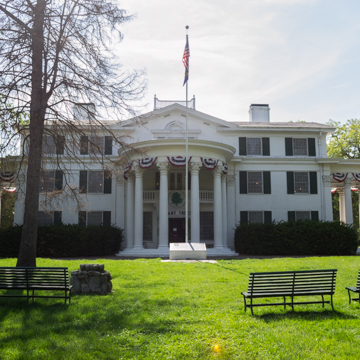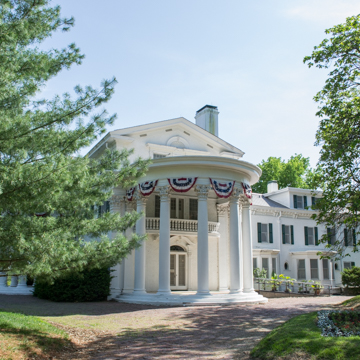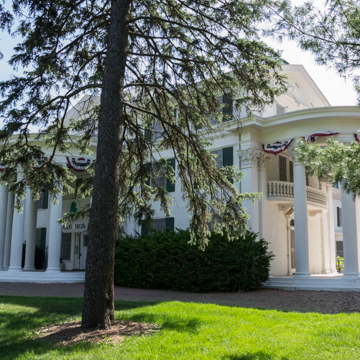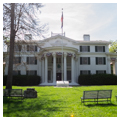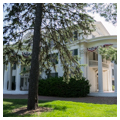You are here
Arbor Lodge
In 1855 J. Sterling Morton and his wife Caroline moved to the Nebraska Territory from Michigan. They settled just outside of Nebraska City and erected a one-and-a-half-story frame cottage. From 1879 to 1880 Morton expanded the house adding a second story with hipped roof and dormers and a two-tiered veranda across the west-facing facade.
Morton died in 1902 and a year later his son, Joy, built a three story, gable-roofed, ninety-foot section on the east side of the original dwelling transforming it into the present Classical Revival mansion. This large frame structure has a stucco façade and a T-shaped plan containing fifty-two rooms. Three identical, semicircular, classically-detailed, two-story porticos shelter the centrally located front entrance and terminate the two ends of the gabled section of the house. Each portico has six fluted Corinthian columns, two pairs of fluted Corinthian pilasters supporting flat-roofed porches, and shelters a semi-elliptically shaped balcony entered from the second floor.
The mansion’s main entrance opens into an impressive thirty-foot square reception hall that leads to living and dining areas which feature Victorian furnishings owned by the Morton family and in the sun parlor, a Tiffany skylight. The second floor contains an assortment of sleeping rooms including Joy Morton’s bedroom and the Cleveland Room, named in honor of President Grover Cleveland. The third floor has an additional ten bedrooms. The mansion currently functions as a museum and several of the second and third floor bedrooms are furnished with family possessions. Immediately west of the main house is a large two-story carriage house and further west is an additional 230 acres containing several large barns, storage facilities, outbuildings, and orchards. All of this parkland was once part of the Morton estate.
After arriving in Nebraska J. Sterling Morton became involved in state politics and business. He served as the Territorial Secretary and Territorial Governor and in 1893 was appointed the Secretary of Agriculture under President Grover Cleveland. Morton was a strong proponent of agriculture in Nebraska, especially tree planting and he led by example, heavily planting his own estate. In 1871 Morton first proposed his idea of having an annual tree-planting day and the first observance occurred the following year. In 1874 the Nebraska legislature adopted its observance as a state holiday. Arbor Day became a national holiday eleven years later. In 1923 Joy Morton gave the house and grounds to the State of Nebraska as a state park in memory of his parents. It was declared a National Historic Landmark in 1969 and is open to the public.
References
Adams, George R., "Arbor Lodge State Park," Otoe County, Nebraska. National Register of Historic Places Inventory-Nomination Form, 1974. National Park Service, U.S. Department of the Interior, Washington, DC.
Olson, James C. J. Sterling Morton: Pioneer Statesman; Founder of Arbor Day. Lincoln, NE: Nebraska State Historical Society, 1972.
Ulbrick, Mary. Arbor Lodge. 2 vols. Nebraska City, NE: Arbor Day Centennial Committee, 1972.
Writing Credits
If SAH Archipedia has been useful to you, please consider supporting it.
SAH Archipedia tells the story of the United States through its buildings, landscapes, and cities. This freely available resource empowers the public with authoritative knowledge that deepens their understanding and appreciation of the built environment. But the Society of Architectural Historians, which created SAH Archipedia with University of Virginia Press, needs your support to maintain the high-caliber research, writing, photography, cartography, editing, design, and programming that make SAH Archipedia a trusted online resource available to all who value the history of place, heritage tourism, and learning.














